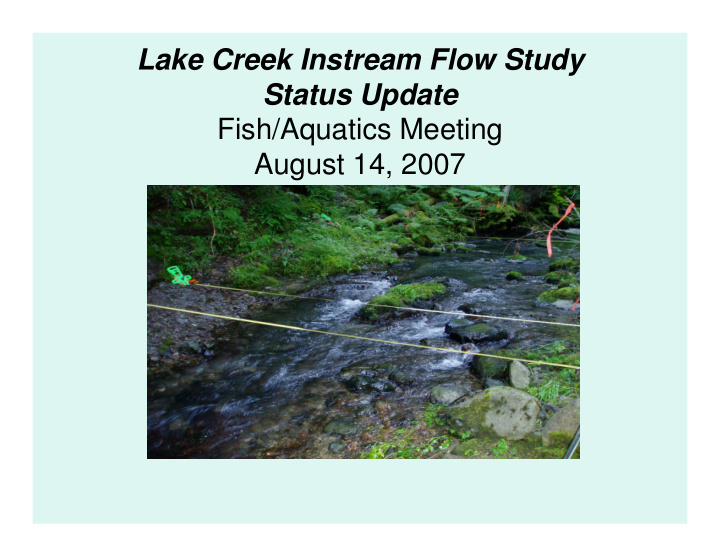



Lake Creek Instream Flow Study Status Update Fish/Aquatics Meeting August 14, 2007
Study Requested by: • Washington Department of Ecology • US Forest Service • US Fish and Wildlife Service
Purpose of Study • Assess the relationship between flow and aquatic habitat in Lower Lake Creek
Status of Investigation • EN conducted physical habitat surveys of Lake Creek in 2004 • 3 calibration flow measurements taken during summer 2004 (3 – 34 cfs) • Spill event for higher flows in 2005 to extend model range
Lake Creek Study Sites and Reaches and Fish Distribution 3,500 Drop Structure SS4 SS3 3,000 2,500 Rainbow Elevation (ft) Steelhead Barrier Barrier Chinook Coho Cutthroat 2,000 SS2 1,500 SS1 Reach 4 Reach 5 Reach 3 Reach 2 Reach 1 1,000 0.0 0.5 1.0 1.5 2.0 2.5 3.0 3.5 4.0 4.5 5.0 5.5 RM
Amphibians • Species and Life Stages Modeled – Giant Salamander ( Dicamptodon spp. ) • Eggs • Larvae – Coastal Tailed Frogs ( Ascaphus truei ) • Eggs • Larvae – Cascade Torrent Salamander ( Rhyacotrin cascadae ) • Eggs • Larvae
Status of Investigation, cont’d • Data reduction and model calibration occurred in Winter 2006 and Spring 2007. – Model calibration – Transect and study site weighting – HSI curves – Monthly inflow estimates between sites • WUA produced for target species and life stages
Weighted Usable Area • Index of Habitat Quantity – Square feet/ 1000 linear feet of stream • Does not Indicate the Quality of the Habitat – Small amount of very good habitat or – Large amount of marginal habitat • It doesn’t indicate where on the transect the habitat is located
Figure 3.3-1 Lake Creek Study Site 1 (T1-4) Fish Rearing Habitat (WUA) vs. Flow 800 WUA (Sq. Ft. of Habitat Per 1000 Ft. of 700 600 500 Stream) 400 300 200 100 0 0 50 100 150 200 250 300 Streamflow in Cubic Feet Per Second (cfs) Chinook Rearing Coho Rearing Steelhead Rearing Cutthroat Rearing Rainbow Rearing Winter Rearing
Figure 3.3-2 Lake Creek Study Site 1 (T1-4) Fish Spawning Habitat (WUA) vs. Flow 40 W U A ( S q . F t . o f H a b it a t p e r 1 0 0 0 F t . o f 35 30 25 S t re a m ) 20 15 10 5 0 0 50 100 150 200 250 Streamflow in Cubic Feet Per Second (cfs) Chinook Spawning Coho Spaw ning Steelhead Spaw ning Cutthroat Spaw ning Rainbow Spaw ning
Figure 3.4-4 Lake Creek IFIM SS4 Amphibian Habitat (WUA) vs. Flow 2,000 1,800 WUA (Sq. Ft. of Habitat per 1000 Ft. of stream) 1,600 1,400 1,200 1,000 800 600 400 200 0 1 51 101 151 201 251 Streamflow in Cubic Feet Per Second (cfs) Larvae Eggs Eggs and Larvae
Input Hydrology • Inflow exists in Lake Creek from the Drop Structure downstream to confluence with the Cowlitz River • Each study site or group of transects will receive differing amounts of inflow • Inflow varies – Site to site – Month to month
Figure 5.2-1 Lake Creek IFIM January: Fish Rearing Habitat (WUA) vs. Flow 7,000 6,500 WUA (Sq. Ft. of Habitat per 1000 Ft. of Stream) 6,000 5,500 5,000 4,500 4,000 3,500 3,000 2,500 2,000 1,500 1,000 500 0 0 50 100 150 200 250 Streamflow in Cubic Feet Per Second (cfs) Chinook Rearing Coho Rearing Steelhead Rearing Cutthroat Rearing Rainbow Rearing Winter Rearing
Figure 5.2-2 Lake C reek IFIM January: Fish Spawning H abitat (W UA ) vs. Flow 80 WUA (Sq. Ft. of Habitat per 1000 Ft. of Stream) 70 60 50 40 30 20 10 0 0 50 100 150 200 250 Stream flow in Cubic Feet Per Second (cfs) C oho Spawning Cutthroat Spawning
Figure 5.3-1 Lake Creek IFIM January Amphibian Habitat (WUA) vs. Flow 4,500 WUA (Sq. Ft. of Habitat Per 1,000 Ft. of Stream 4,000 3,500 3,000 2,500 2,000 1,500 1,000 500 0 0 50 100 150 200 250 Streamflow in Cubic Feet Per Second (cfs) Giant Salamander Larvae Tailed Frog Larvae Torrent Salamander Larvae
Anticipated Completion of Field Study • Field work has been completed for this study.
Anticipated Draft Study Report Due Date: • Habitat Assessment report finalized in 2005 • The draft report with modeling results was distributed in June 2007
Modifications to Ongoing Studies or New Studies Proposed by Applicant • No modifications to ongoing studies or new studies are being proposed. • Energy Northwest is currently running various scenarios that examine historic flow conditions in Lake Creek • Energy Northwest is also modeling the effects of habitat enhancement on the anadromous reaches of Lake Creek
Recommend
More recommend